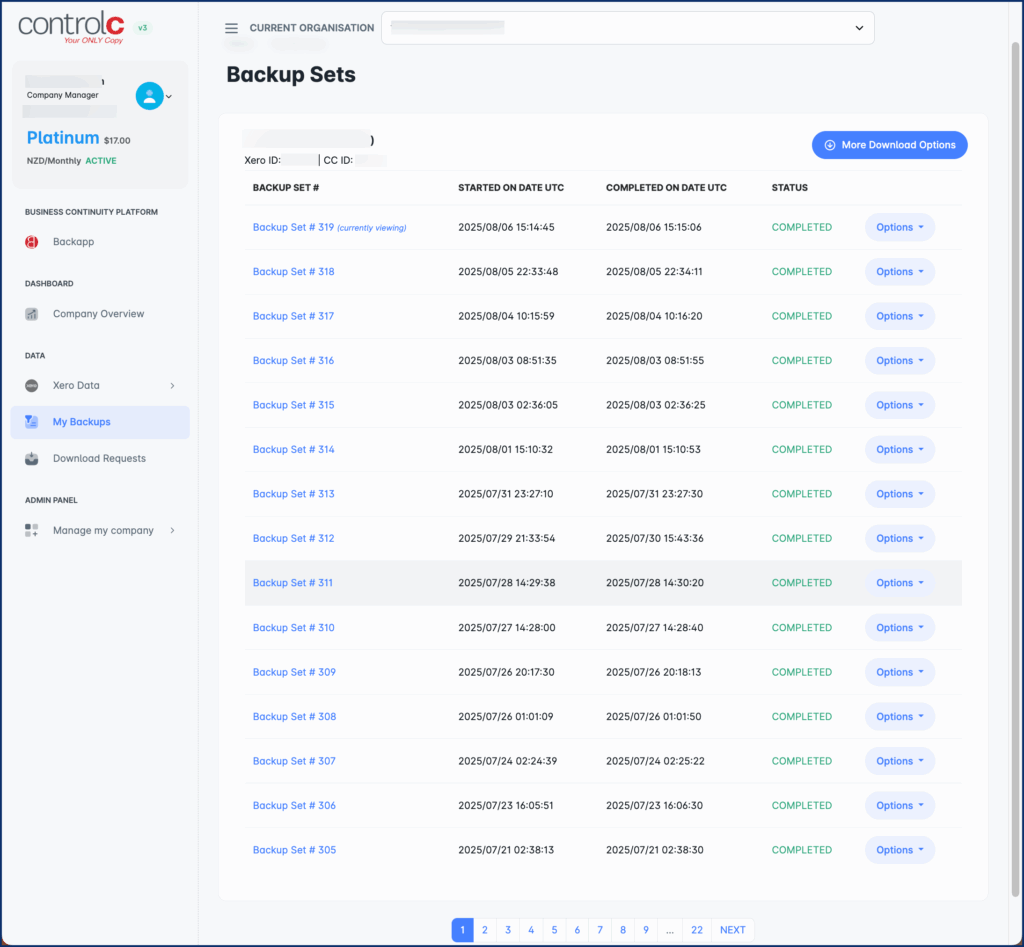
Free Trial

Free Trial

Free Trial
At Control-C, we believe that business continuity starts with data independence. Our automated, versioned backups ensure that your critical data is always accessible, recoverable, and under your control—no matter what happens to your SaaS provider.
Whether it’s a system failure, human error, or a compliance audit, Control-C gives you the power to recover, report, respond and keep your business operational —without waiting on a vendor.
That’s not just backup. That’s business continuity.
Don’t let SaaS vulnerabilities leave you stranded – secure your data with backups today!
SaaS platforms, while offering flexibility and scalability, introduce supply chain risks due to their reliance on third-party providers and interconnected services.
If a SaaS platform uses the likes of AWS or Azure for its cloud infrastructure, any security vulnerabilities or outages within those providers can directly impact the SaaS platform's availability, data integrity and disrupt operations, impacting the entire ecosystem.
Have you read them? Adhering to a SaaS provider's Terms of Use is crucial as it legally binds both parties, outlining permissible usage, data handling, and liability. Non-compliance can lead to service termination.
You are required to backup your data inputted into their systems. Non-compliance can lead to service termination, legal disputes, and reputational damage, highlighting the importance of understanding and upholding these agreements.
User errors, such as accidental deletions, overwrites, or incorrect data entry, are a leading cause of data loss. Highlighting the importance of robust backup and recovery solutions
Even seemingly minor mistakes can have significant consequences, highlighting the importance of robust backup and recovery solutions to mitigate the risks associated with human fallibility.
Ranging from ransomware to data breaches the increasingly sophisticated Cyber Attacks all pose a serious threat to businesses...
...potentially leading to catastrophic data loss or prolonged service outages. These malicious attacks can cripple operations, compromise sensitive information, and result in significant financial and reputational damage.
For over 12 years, Control-C has been the leading innovator in Xero and Xero Practice Manager backups, serving Xero users globally with a proven track record of success. We also offer backups for Cin7 Omni, providing comprehensive data protection for businesses of all sizes. We partner with MSP resellers and CPA practice partners to provide our clients with the best possible service and support.
Our comprehensive backup solutions ensure that your Xero, Xero Practice Manager, and Cin7 Omni data is always protected, no matter what happens. We offer automatic backups daily, as well as a one-time full backup option.
Their first backup was almost 11 years ago and we still hold the data on file as a current subscriber to our service…


With Control-C, you can rest assured that your critical business data is safe and secure. We are committed to providing our clients with the highest quality service and support, and we are always here to help you with your backup needs.

Where’s your copy of your Xero data? If you rely solely on Xero, the answer is: there is no copy. Xero holds the only version of your data and even Xero’s own terms warn you to back it up: “You must maintain copies of all data inputted into the service. Xero expressly excludes liability for any data loss no matter how caused.”[1]. In other words, Xero doesn’t do backups for you – that’s on you.
Bottom line: Xero’s awesome for daily operations, but it wasn’t designed to protect you from worst-case scenarios. That’s your responsibility – and it’s where Control-C comes in.
Many backup services for Xero don’t solve the real problem: keeping your business running during a Xero failure. Here’s what typically happens with other solutions:
Control-C is built from the ground up with one goal: Keep you in business, no matter what happens to Xero. We don’t just copy your Xero data; we serve it to you on an independent platform that’s always available. Here’s how Control-C stands apart:
Xero is critical to your business – protect it like it is. Imagine the next Xero outage or breach happens tomorrow. Will you be calmly executing your continuity plan with Control-C, or scrambling with CSV files and hoping for the best?
Take control now. Join the smart businesses who have made Control-C a fundamental part of their operations. It’s quick to set up, easy to use, and it just might save your business one day.
Ready to secure your Xero data and never worry about “what if”? Start your free trial of Control-C or contact our team to see how we can safeguard your business. Don’t let your business hang on a single point of failure. Backup is good – but keeping your business running is even better. Control-C delivers both. Act now, and ensure that an unexpected Xero failure is nothing more than a minor bump in the road, not a catastrophe. Your business continuity begins here.



Since 2012, Control-C has earned the trust of thousands of businesses globally by delivering reliable, secure, and user-friendly backup solutions for Xero, Xero Practice Manager, and Cin7 Omni.
Here’s what our customers consistently say:
“Control-C gives us confidence that our financial data is safe, even if something goes wrong with our SaaS provider.”
Customers appreciate knowing their data is backed up daily and stored securely in sovereign New Zealand data centres, ensuring compliance with privacy laws and business continuity.
“Setup was a breeze, and the interface is intuitive. We were up and running in minutes.”
Control-C is designed for simplicity. Users love how easy it is to get started and manage backups without technical overhead.
“We finally have visibility into our Xero data history and the ability to restore exactly what we need.”
With Control-C’s versioned backups and business intelligence layer, customers gain full control over their data—something they never had with native SaaS platforms.
“The support team is fantastic—quick, knowledgeable, and genuinely helpful.”
Our customer-first approach means users get fast, friendly assistance whenever they need it.
“Even though we’re based overseas, the service feels personal and responsive.”
Control-C serves customers in 18+ countries, maintaining a high NPS (metric that measures customer loyalty and satisfaction) and 5-star reviews across platforms.
Rest asure, sleep well
Franco van Vuuren
Wow, I was super surprised to learn that I need to do backups on Xero. Then I found Control-C. Pheew, I now sleep well at night, knowing it is all backed up! Campbell and the team is super clued-up, and the “handholding” during that first couple of weeks (API limits on Xero’s side mean that the first full backup takes time) was awesome! Even the time difference (NZ – SA) did not stand in their way to assist!
One-Off backup
John Jacobson
I purchased the one-off backup when finishing with Xero. Control C had the most comprehensive solution and makes looking up historical account data very simple. The support has been excellent, and I would highly recommend this product, either so you have piece of mind of a regular backup, or, like myself, needed a one-off solution to move on from Xero.
Fantastic support team
Tony Holt of Sales
In the unlikely event you need help from the support team, you can be confident that they will deliver timely and clear support to solve any issues that may arise. This is great software for ensuring you have backup copies of your data.
Great service
Patrick Dedat Humphrey
I am migrating from Xero to FreeAgent, primarily because I can get it free with a Mettle bank account. I needed to download all the information and attachments from Xero for record keeping purposes. ControlC was great for this purpose and once I understood how it worked, the one off download was a breeze and very cost effective compared to some of it’s competitors. Campbell Green, the founder, was very responsive to my queries – I would definitely recommend this service whether as a one off or as a regular backup.
Great App
Michael Chan
Cheap peace of mind in case something happens to Xero and the bank connection (like what happened once back in 2019).
Peace of Mind and great support
Barry Dowd
Excellent backup solution for peace of mind. Customer support is outstanding.
Easy to setup and reliable
Yujing Leong
The setup was intuitive and easy to follow guides were also provided. The customer service for questions or guidance has been answered promptly and professionally. In terms of the app, it is good i.e. dashboard, email triggers. I recommend it
Providing peace of mind
Roger Grove
control is easy to use and reliable. I recommend it to all Xero users. It is a small price to ensure the security of your data, and security of your data is the only way to ensure business continuity.


WhatsApp us